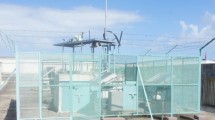Abstract
The paper introduces the discussion about possible application of very large scale PV systems in Israel. An application of very large scale PV production units of 100 and 500 MW, similar to the unit size of a conventional power station is proposed. A comparative evaluation between conventional power stations and PV stations is carried out in relation to the issues of: geographical location, fuel, pollution, sustainability, availability, watt construction cost and operational characteristics. Calculated payback shows that it decreases from 19 years in 2003 to about 4 years in 2020. Based on worldwide experience of the western countries it is recommended that the country should establish a national program to support the development of PV production and applications.
Similar content being viewed by others
References
American Capital Energy and Brook Wavehousing, Available from http://www.Solarbuzz.com
Cho, K. and Kim, K., Solar Lend 2010, Program for PV R&D and Dissemination in Korea, Proc. 3rd World Conf. on Photovoltaic Energy Conversion, Osaka, 2003.
De Lillo, A., Li Causi, S., Castello, S., and Gaustella, S., Solar Land PV Technology Status and Perspectives in Italy, Proc. 3rd World Conf. on Photovoltaic Energy Conversion, Osaka, 2003.
Dumbs, C. and Juquois, F., The French off-Grid Electrification Program - an Eight Year Experience Report, Proc. 3rd World Conf. on Photovoltaic Energy Conversion, Osaka, 2003.
Emerging Energy Research, New Market Study, 2008, Solar PV Development Strategies in Europe, 2008-2020.
Green, M.A., Third Generation Photovoltaic: Ultra High Conversion Efficiency at Low Cost, Progr. Photovoltaic: Res. Appl., 2001, vol. 9, pp. 123–135.
Hamakawa, Y., 30 Years of Solar Photovoltaic Research, Proc. 3rd World Conf. on Photovoltaic Energy Conversion, Osaka, 2003.
Israel Electric Company (IEC). Statistical Annual Report, 2004.
Israel Electric Company Statistics, Available from www.israel-elektric.co.il/static/work-folder/Hpmeclients/current-tariffs, 2007.
Israel Electric Company (IEC), Electricity Tariff, 2008.
Jager-Waldau, A., A European Roadmap for PV R&D, Proc. 3rd World Conf. on Photovoltaic Energy Conversion, Osaka, 2003.
Jager-Waldau, A. and Ossenbrink, H., Progress of Electricity from Biomass, wind and Photovoltaics in European Union, Renewable and Sustainable Energy Reviews, 2004, vol. 8, pp. 157–182.
Jivacate, C. and Buakhiew, C., Photovoltaic (PV): Status & Future Development in Thailand, Proc. 3rd World Conf. on Photovoltaic Energy Conversion, Osaka, 2003.
Energy from the Desert, Kurokawa, K., Ed., London: James & James, 2003.
Malm, U. and Stolt, L., National Survey Report of PV Power Applications in Sweden 2006, Angstrom Solar Center, Uppsala University, 2007.
Public Utilities Authority Electricity, Feed-in-Tariff Scheme for Small PV Stations in Israel, 2008.
Perz, R., Herig, C., and Letendre, S., PV and Grid Reliability. Availability of PV Power During Capacity Shortfalls, Available from http://www.asrc.cestm.albany.edu/perz/asas2001-outages/paper-outage.pdf.
PVresources, 2007. World’s Largest PV Power Plants, Available from www.PVresources.com, 2007.
Renewable Energy Policy, Government of Israel, Decision, 2002, no. 44.
Sakamoto, S. and Oshiro, T., Field Test Results on the Stability of Silicon Photovoltaic Modules, Manufactured in the 1990th, Proc. 3rd World Conf. on Photovoltaic Energy Conversion, Osaka, 2003.
Sayigh, A., World Renewable Energy, Proc. 3rd World Conf. on Photovoltaic Energy Conversion, Osaka, 2003.
Solarbuzz, 2007.
Solarbuzz Consultancy Reports, Solar Module Retail Price Environment, June 2008.
Surek, T., Progress in U.S. Photovoltaic: Looking back 30 Years and Looking ahead 20, Proc. 3rd World Conf. on Photovoltaic Energy Conversion, Osaka, 2003.
Spanos, I. and Duckers, L., Expected Cost Benefic of Building-Integrated PVs in UK, through a Quantitative Economic Analysis of PVs in Connection with Buildings, Focused on UK and Greece, Renewable Energy, 2004, vol. 29, pp. 1289–1303.
U.S. Department of Energy, Energy Information Administration (EIA), Monthly Energy Review, Feb. 2006.
U.S. Department of Energy. Solar Energy Technologies Program, Multi-Year Technical Plan 2003-2007 and beyond, 2003.
U.S. Department of Energy. Energy Information Administration, World Oil Market and Oil Price Chronologies: 1970-2005, 2005.
Weiss, L., Sprau, P., and Helm, P., The German PV Solar Power Financing Schemes Reflected on the German PV Market, Proc. 3rd World Conf. on Photovoltaic Energy Conversion, Osaka, 2003.
Author information
Authors and Affiliations
Additional information
The article is published in the original.
An erratum to this article can be found at http://dx.doi.org/10.3103/S0003701X10010184
About this article
Cite this article
Vinter, G., Slonim, M. Introducing very large scale PV systems in Israel. Appl. Sol. Energy 45, 224–232 (2009). https://doi.org/10.3103/S0003701X09040021
Received:
Published:
Issue Date:
DOI: https://doi.org/10.3103/S0003701X09040021




